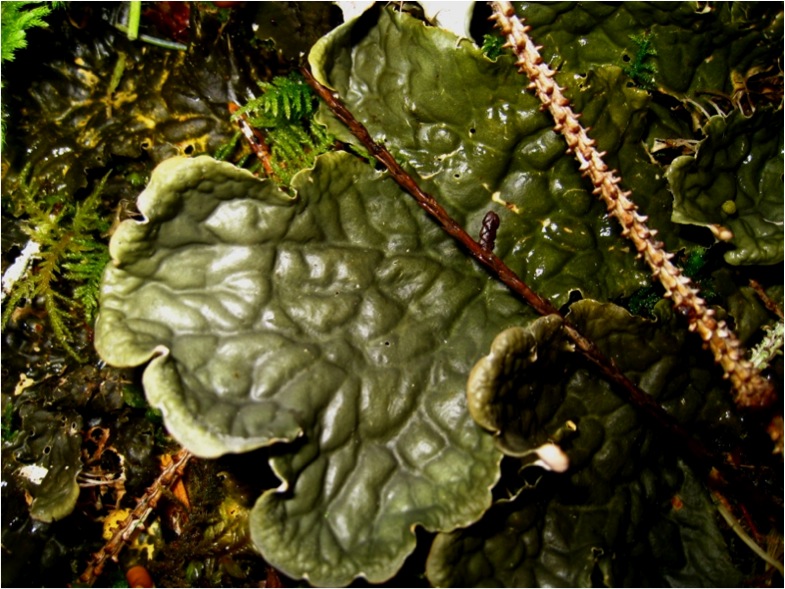Frog pelt, undulating pelt • Peltigera neopolydactyla*, P. polydactyla var. neopolydactyla
Identification
Frog pelt is a large leaf lichen with broad 10-25 mm wide lobes. The upper surface varies in colour from olive-green to pale or dark bluish-grey. The upper surface is hairless, often with pointy brownish fruiting bodies (apothecia) along lobe margins. The underside is whitish and cottony in texture, with low, wide, brownish or black veins. The underside also has long and thin holdfasts (rhizines), which are whitish as well. They are visible (pointing downwards) in this photo. Frog pelt uses these holdfasts to lie loosely against substrates (loosely appressed).
Habitat & Range
Frog pelt grows on moss, mossy rocks, logs, and in soil. It is a common species, and is found in moist open or shaded forests of all elevations. It is found in most circumpolar regions. Along the west coast of North America it is found as far south as California.
Similar Species
Fringed pelt (Peltigera pacifica) and pioneer pelt (P. polydactylon) are similar pelt species that can be differentiated from frog pelt by their frilled lobe margins.
Intriguing Info
*BC has at least 29 different species of Peltigeras - this accounts for most of the species found in North America.
Current research is revealing that Peltigera neopolydactyla may actually form part of a larger, complicated species complex with multiple well-known lichen species; this indicates that lichens previous described as P. neopolydactyla may actually be composites of it as well as other species, some currently undescribed. As of now this complex is known as the Peltigera neopolydactyla-dolichorhiza complex. See the Peltigera Project page for this complex to find out more.
Frog pelt is a large leaf lichen with broad 10-25 mm wide lobes. The upper surface varies in colour from olive-green to pale or dark bluish-grey. The upper surface is hairless, often with pointy brownish fruiting bodies (apothecia) along lobe margins. The underside is whitish and cottony in texture, with low, wide, brownish or black veins. The underside also has long and thin holdfasts (rhizines), which are whitish as well. They are visible (pointing downwards) in this photo. Frog pelt uses these holdfasts to lie loosely against substrates (loosely appressed).
Habitat & Range
Frog pelt grows on moss, mossy rocks, logs, and in soil. It is a common species, and is found in moist open or shaded forests of all elevations. It is found in most circumpolar regions. Along the west coast of North America it is found as far south as California.
Similar Species
Fringed pelt (Peltigera pacifica) and pioneer pelt (P. polydactylon) are similar pelt species that can be differentiated from frog pelt by their frilled lobe margins.
Intriguing Info
*BC has at least 29 different species of Peltigeras - this accounts for most of the species found in North America.
Current research is revealing that Peltigera neopolydactyla may actually form part of a larger, complicated species complex with multiple well-known lichen species; this indicates that lichens previous described as P. neopolydactyla may actually be composites of it as well as other species, some currently undescribed. As of now this complex is known as the Peltigera neopolydactyla-dolichorhiza complex. See the Peltigera Project page for this complex to find out more.
References
Goward, T., McCune, B., and Meidinger, D. Peltigera neopolydactyla (Gyelnik) Gyelnik. In Klinkenberg, Brian. (Ed.). E-Flora BC: Electronic Atlas of the Plants of British Columbia. Lab for Advanced Spatial Analysis, Department of Geography, University of British Columbia, Vancouver. Accessed 11/04/2014.
Pojar, J. and MacKinnon, A. (1994). Plants of Coastal British Columbia. Vancouver, BC: Lone Pine Publishing. P. 490.
Authors and editors of page
Kelly Fretwell and Brian Starzomski (2014).
Goward, T., McCune, B., and Meidinger, D. Peltigera neopolydactyla (Gyelnik) Gyelnik. In Klinkenberg, Brian. (Ed.). E-Flora BC: Electronic Atlas of the Plants of British Columbia. Lab for Advanced Spatial Analysis, Department of Geography, University of British Columbia, Vancouver. Accessed 11/04/2014.
Pojar, J. and MacKinnon, A. (1994). Plants of Coastal British Columbia. Vancouver, BC: Lone Pine Publishing. P. 490.
Authors and editors of page
Kelly Fretwell and Brian Starzomski (2014).





